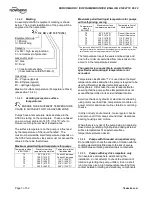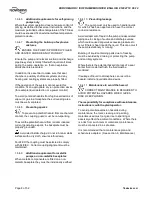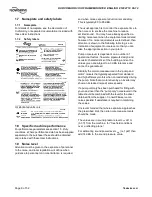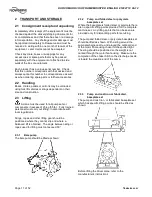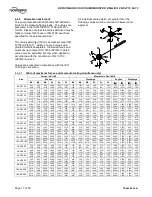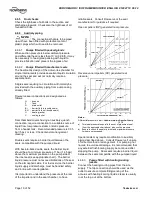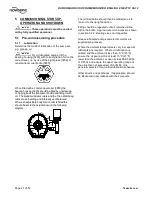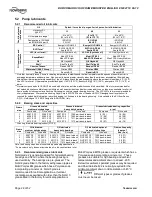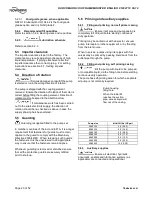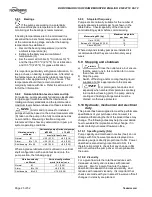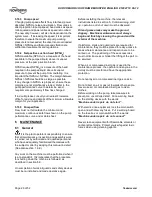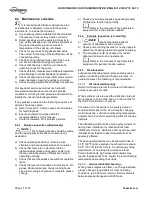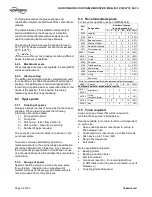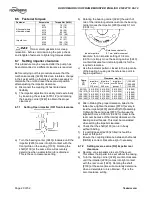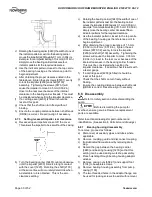
DURCO MARK 3 ISO FRAME MOUNTED ENGLISH 85392719 06-12
Page 15 of 52
flowserve.com
Tighten down and repeat the same procedure on all
other feet until all are within tolerance.
Complete piping as below and see sections 4.8,
Final shaft alignment check, up to and including section
5, Commissioning, startup, operation and shutdown,
before connecting driver and checking actual rotation.
4.6 Piping
Protective covers are fitted to the pipe
connections to prevent foreign bodies entering during
transportation and installation. Ensure that these
covers are removed from the pump before connecting
any pipes.
4.6.1 Suction and discharge pipework
Never use pump as a support for piping.
Maximum forces and moments allowed on the pump
flanges vary with the pump size and type. To minimize
these forces and moments that may, if excessive, cause
misalignment, hot bearings, worn couplings, vibration
and the possible failure of the pump casing, the
following points should be strictly followed:
•
Prevent excessive external pipe load
•
Never draw piping into place by applying force to
pump flange connections
•
Do not mount expansion joints so that their force,
due to internal pressure, acts on the pump flange
Ensure piping and fittings are flushed
before use.
Ensure piping for hazardous liquids is arranged
to allow pump flushing before removal of the pump.
Take into account the available NPSH which must be
higher than the required NPSH of the pump.
Non self-primer casings
4.6.1.1
In order to minimize friction losses and hydraulic
noise in the pipework it is good practice to choose
pipework that is one or two sizes larger than the
pump suction and discharge. Typically main
pipework velocities should not exceed 2 m/s (6
ft./sec) suction and 3 m/s (9 ft./sec) on the discharge.
Self-priming casing
4.6.1.2
The delivery pipework must permit priming air to
escape unhindered from the pump during the priming
cycle, without back pressure and prevent excessive
run-back of liquid on shutdown to minimize syphoning.
Priming air may be vented in one of the following ways:
1) The discharge pipework regulating valve, if fitted,
may be partly opened during the priming cycle to
freely vent the air.
2) An automatic air release valve may be fitted to the
discharge pipework, between the pump and any
valves, providing that gases and vapors given off
are environmentally safe and acceptable for
release into the atmosphere.
3) An air bleed pipe may be run from the discharge
pipework, between the pump and any valves, back
to the suction tank or sump. This arrangement has a
disadvantage in that manual/automatic control will be
necessary during operation to prevent continuous re-
circulation of the pumped liquid.
4.6.2
Suction piping
Non self-primer casing suction piping
4.6.2.1
a) The inlet pipe should be one or two sizes larger
than the pump inlet bore and pipe bends should
be as large a radius as possible.
b) On suction lift the piping should be inclined up
towards the pump inlet with eccentric reducers
incorporated to prevent air locks.
c) On positive suction, the inlet piping must have a
constant fall towards the pump.
d) The pipe next to the pump should be the same
diameter as the pump suction and have a minimum
of two pipe diameters of straight section between
the elbow and the pump inlet flange. Where the
NPSH margin is not large, it is recommended that
the pipe straight is 5 to 10 pipe diameter. (See
section 10.3, Reference 1.) Inlet strainers, when
used, should have a net 'free area' of at least three
times the inlet pipe area.
e) Fitting isolation and non-return valves will allow
easier maintenance.
f) Never throttle pump on suction side and never
place a valve directly on the pump inlet nozzle.
Self-priming casing suction piping
4.6.2.2
a) The inlet pipe should be as short as possible,
airtight and the smallest volume as practical for the
pump flow rate so as to be able to prime quickly.
Where inlet pipe volume is large an inlet ball-foot
valve or flap valve will be required.
b) It is recommended that the pump inlet pipe is no
larger than the pump inlet bore or such that the
suction velocity is in the range of 3 to 5 m/s
(10 to 16 ft./sec). The piping should slope down
towards the pump casing suction flange.
c) Take into account the available NPSH, which must
be higher than the required NPSH of the pump.
d) Allow a minimum of two pipe diameters of straight
section between the elbow and inlet flange.
Summary of Contents for Durco Mark 3
Page 49: ...DURCO MARK 3 ISO FRAME MOUNTED ENGLISH 85392719 06 12 Page 49 of 52 flowserve com Notes ...
Page 50: ...DURCO MARK 3 ISO FRAME MOUNTED ENGLISH 85392719 06 12 Page 50 of 52 flowserve com Notes ...
Page 51: ...DURCO MARK 3 ISO FRAME MOUNTED ENGLISH 85392719 06 12 Page 51 of 52 flowserve com Notes ...







